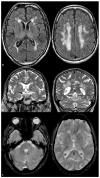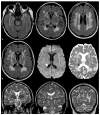ABCC6 Involvement in Cerebral Small Vessel Disease: Potential Mechanisms and Associations
- PMID: 40725385
- PMCID: PMC12296144
- DOI: 10.3390/genes16070728
ABCC6 Involvement in Cerebral Small Vessel Disease: Potential Mechanisms and Associations
Abstract
ABCC6, a key regulator in ectopic calcification, plays a crucial role in mineralization through the modulation of extracellular purinergic pathways and production of inorganic pyrophosphate (PPi), which inhibits calcification. Inherited deficiencies in ABCC6 lead to pseudoxanthoma elasticum (PXE) and related conditions, characterized by calcification in various tissues, particularly affecting the skin, eyes, and cardiovascular system. Although PXE does not directly impact the nervous system, secondary neurological issues arise from cerebrovascular complications, increasing the risk of strokes linked to arterial blockages resembling atherosclerosis. This review investigates the connection between ABCC6 mutations and cerebral small vessel disease (SVD), expanding the understanding of PXE and related phenotypes. Mutations in ABCC6, identified as causing PXE, contribute to systemic metabolic dysfunction, with significant implications for cerebrovascular health. An association between ABCC6 mutations and cerebral SVD has been suggested in various studies, particularly in populations with distinct genetic backgrounds. Emerging evidence indicates that pathogenic mutations increase the risk of ischemic strokes, with both homozygous and heterozygous carriers showing susceptibility. Mechanistically, ABCC6 deficiency is implicated in dyslipidemia and atherosclerosis, further exacerbating cerebrovascular risks. Increased arterial pulsatility, linked to carotid siphon calcification, may also contribute to microvascular damage and subsequent brain injury. Understanding these mechanisms is vital for developing targeted diagnostic and therapeutic strategies for managing cerebrovascular risks in PXE patients. This review emphasizes the need for comprehensive genetic screening and the consideration of traditional vascular risk factors in patient management, highlighting the complex interplay between genetic mutations and environmental influences affecting cerebrovascular health. Future research should focus on longitudinal studies to elucidate the causal pathways linking arterial calcification, pulsatility, and brain damage in PXE.
Keywords: ABCC6; SVD; calcifications; lacunar; small vessel disease; stroke.
Conflict of interest statement
The authors declare no conflicts of interest.
Figures


Similar articles
-
Bone Marrow-Derived ABCC6 Is an Essential Regulator of Ectopic Calcification In Pseudoxanthoma Elasticum.J Invest Dermatol. 2024 Aug;144(8):1772-1783.e3. doi: 10.1016/j.jid.2024.01.026. Epub 2024 Feb 15. J Invest Dermatol. 2024. PMID: 38367909 Free PMC article.
-
Novel treatment for PXE: Recombinant ENPP1 enzyme therapy.Mol Ther. 2024 Nov 6;32(11):3815-3820. doi: 10.1016/j.ymthe.2024.09.028. Epub 2024 Sep 27. Mol Ther. 2024. PMID: 39342427
-
Correlation of systemic involvement and presence of pathological skin calcification assessed by ex vivo nonlinear microscopy in Pseudoxanthoma elasticum.Arch Dermatol Res. 2023 Sep;315(7):1897-1908. doi: 10.1007/s00403-023-02557-x. Epub 2023 Feb 27. Arch Dermatol Res. 2023. PMID: 36847829 Free PMC article.
-
Pseudoxanthoma elasticum veiled as vasculitis: shedding light on an uncommon disorder and an in-depth review of the literature.Rheumatol Int. 2024 Feb;44(2):379-396. doi: 10.1007/s00296-023-05509-w. Epub 2023 Dec 23. Rheumatol Int. 2024. PMID: 38141121
-
Cerebral disease in a nationwide Dutch pseudoxanthoma elasticum cohort with a systematic review of the literature.J Neurol Sci. 2017 Feb 15;373:167-172. doi: 10.1016/j.jns.2016.12.053. Epub 2016 Dec 28. J Neurol Sci. 2017. PMID: 28131180
References
-
- Jansen R.S., Küçükosmanoğlu A., de Haas M., Sapthu S., Otero J.A., Hegman I.E.M., Bergen A.A.B., Gorgels T.G.M.F., Borst P., van de Wetering K. ABCC6 prevents ectopic mineralization seen in pseudoxanthoma elasticum by inducing cellular nucleotide release. Proc. Natl. Acad. Sci. USA. 2013;110:20206–20211. doi: 10.1073/pnas.1319582110. - DOI - PMC - PubMed
Publication types
MeSH terms
Substances
LinkOut - more resources
Full Text Sources

